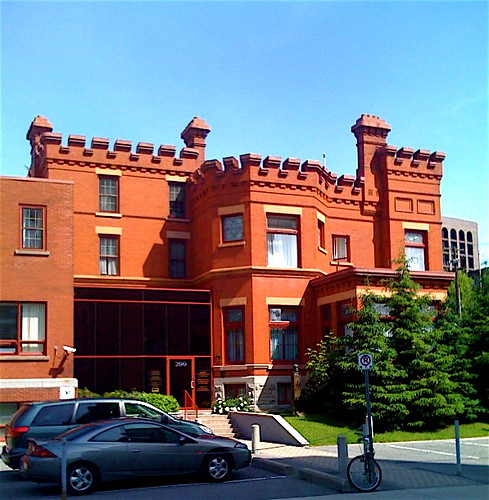
When it was recently announced that Jim Watson would be joining the mayoral race, I began to think about mayors and their stamps of the city’s built environment. In a capital city that duly celebrates ‘nation-builders’ where can we find the ‘city-builders’? When I started to dig a little it turns out that Ottawa’s mayors — particularly those from the first half of the 20th century — haunt the city everywhere, in street signs, bridges and hospitals they advocated for, decadent ‘castles’ they lived in, and swimming pools.
Lyon Street is named for the mayor who had the honour of celebrating Confederation — Robert Lyon was the mayor in 1867 and was a serious man, most notable for having a family full of famous characters, and the longest beard in Ottawa’s mayoral history.
The delightful community centre: the Plant Bath at the corner of Preston and Somerset is named for Frank Plant, the mayor in 1921-23, and 1930. Seems that Plant was the ‘fun mayor’ who enjoyed sleigh-riding to the non-prohibition affected Hull and whose most notable suggestions were to establish a city zoo and city-owned golf course (neither happened). The Plant and Champagne baths were also his ideas. These baths were built in 1924 as part of the public health movement at the time. They were soon transformed into public swimming pools.
On Metcalfe Street, there are not one but two ‘castles’—the well-known Museum of Nature, and what is known as “Birkett Castle” Birkett Castle, at 306 Metcalfe, has been the headquarters of the Boy Scouts and most recently as the Hungarian Embassy. However, it was built in 1895 for the Thomas Birkett, hardware merchant and Ottawa mayor in 1891. With a short mayoralty in a time of recession, Birkett did not accomplish much, but was the mayor during the opening of electric streetcar.
The one mayor honoured with a figurative statue is Harold Fisher, Mayor (1917-20). His statue is appropriately in front of the Ottawa Civic Hospital, Fisher’s most significant and controversial accomplishment during his mayoralty. Mayor during the 1918 outbreak of the Spanish flu, Fisher spent much of his time as mayor improving health infrastructure in the city. During the outbreak, which took 520 Ottawa citizens, Fisher closed schools, theatres, churches and persuaded the streetcar companies to prevent standing in an attempt to reduce crowding. His proposal to build the hospital in its current location on Carling Ave was chided by many as being too far—earning the project the nickname “Fisher’s Folly.” The monument to Fisher, unveiled in 1928 three years after his death, is by a renowned sculptor George Hill (he also sculpted the monuments to D’arcy McGee and George Brown).The inscription sums up Fisher’s accomplishment: “if you would see his monument, look around you.”

Their legacies may be forgotten, but their names still ring a bell: Fisher, Friel, Scott, Rochester, Lyon, Stewart, Lewis, Waller, Champagne. My next post I am going to dedicate entirely to the two mayors who challenged City Hall’s glass ceiling: Charlotte Whitton and Marion Dewar.
References: Mullington, Dave Chain of Office: Biographical Sketches of the Early Mayors of Ottawa (1847-1948) Renfrew: General Store Publishing House.
Maitland, Leslie and Louis Taylor 1990. Historical Sketches of Ottawa Peterborough: Broadview Press.

3 comments
I think the tower beside Main Library is what is called the Sir Richard Scott building.
It may be more accurate to say that the OPL Main Branch is part and parcel of the Sir Richard Scott Building.
This is an awesome post! I look forward to read about the mayoral gals!